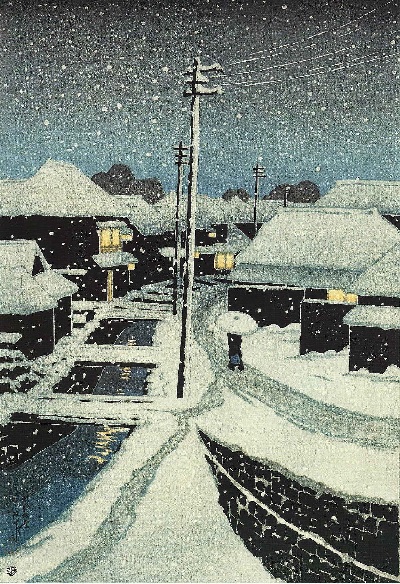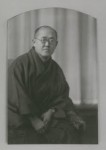
Kawase Hasui
Japanese, 1883-1957
Terajima Village in Twilight Snow, 1920
color woodblock print on paper
14 1/4 x 9 1/2 in.
SBMA, Gift of Dr. and Mrs. Roland A. Way
1991.147.26

Kawase Hasui - The Lavenberg Collection of Japanese Prints
"I do not paint subjective impressions. My work is based on reality...I can not falsify..(but) I can simplify…I make mental impressions of the light and color at the time of sketching. While coloring the sketch, I am already imagining the effects in a woodblock print." - Kawase Hasui
RESEARCH PAPER
Kawase Hasui is a prolific landscape printmaker in early 20 th century. He created watercolors and drawings for more than 600 prints with publishers such as Watanabe Shozaburo who is an advocate of the Shin Hanga ("new prints") movement.
Hasui studied naturalistic Shijo school and oil painting before he joined the studio of Kaburagi Kiyokata, a master of Nihon-ga, Japanese painting. (Art academy of the time was divided into two departments - one is Japanese painting, traditional, mainly watercolor and the other, western painting, or oil painting.) An artist like Hasui who was trained in both was the perfect candidate for the new movement of Shin Hanga.
The publishers in early 20 th century continued to produce the reproductions of famous ukiyo-e of the 18 th and 19 th centuries, such as Hokusai and Hiroshige, mostly for foreign clientele, who were then the greatest collectors of the old prints. Watanabe Shozaburo (1885-1962) saw it ripe to introduce new creative prints using the popular traditional woodblock print medium.
Shin Hanga artists looked for beauty in landscape, townscape, theatrical art and traditional femininity in modern Japan using traditional woodblock print production system. It is an effort to reappraise the popular medium among foreigners and search for the creative expression of those aspects of Japanese aesthetics.
Around the same time another group of printmakers gathered under the banner of "Sosaku Hanga" (Creative Prints) and they criticized that the creative aspects of the artist could not be transmitted through professional carvers and printers, and also that Shin Hanga publishers were more motivated in commercial success than creative expressions of the artist.
Since 1917 through his death in 1957, for 40 years Hasui traveled extensively throughout Japan. During these sketch trips he produced watercolors and drawings based on which prints were made. Most of Hasui's prints were crafted by a team of artisans employed by the publisher, such as Watanabe. Although the extent of his role was in a way limited as in the case of traditional woodblock print artists, Hasui commented on the importance of the trial printing when he and the printer worked together breathing in perfect unison like a singer and accompanying shamisen (string instrument) player. (You can replace it as a singer and a pianist.) In the traditional woodblock print production, although carvers and printers are considered as technicians or artisans while the designers as artists, the relationship is more complicated. Kendall Brown quotes Hasui's words in his book in "Kawase Hasui: The Complete Woodblock Prints", "Hasui tells of his unparalleled satisfaction - 'something painters can never know' - in watching the printer bring out precisely the color he had in mind". Among Shin Hanga artists Yoshida Hiroshi and his son Toshi did carve and print by themselves, but Hasui did not.
He was a leading artist featured at the two exhibitions held in the Toledo Art Museum, Ohio in 1930 and 1936. He became a well-known Japanese printmaker in US before the Pacific War. During the post-war occupation time, both Yoshida Hiroshi and Hasui were very popular among the soldiers and civilians alike, so much so that their prints were sold wholesale to Occupation authorities then retailed at the base post-exchanges.
In 1952, the Ministry of Education decided to designate woodblock-printing technique as Intangible Cultural Asset and debated the two techniques applied by the Shin Hanga (New Print) group and Sosaku Hanga (Creative Print) group. In the end Sosaku Hanga artists were disqualified, as they did not use traditional techniques. Since Shin Hanga relied on three persons (artist, carver and printer), it was decided that no one artist or work should be singled out as an important cultural property.
In 1956 Hasui's contribution to the medium was acknowledged by the Japanese Government and he was honored as a "Living National Treasure".
In over 600 landscapes and townscapes prints produced during his career, Hasui presented beautiful, tranquil images of countryside and everyday life that were disappearing rapidly from the modern Japanese scenes. His works evoke poetic and nostalgic memories of an idealized era before the modern, westernized cities with factories, noisy traffic and crowds of commuters were settled in.
Hasui's idealization of the city is well noted in his popular print, "Evening snow of Terajima Village". Kendall Brown writes, "By 1920 Terajima better known by its later name, Tamanoi, was a working class area east of the Sumida River which became a low-class brothel district. Hasui's print romanticizes the area, transforming the district into a cozy village by adding the solitary figure who journeys homeward through the heavy snow."
As I recall from my childhood memory, the stench from the stream flowing side of the houses like in the print was pretty awful as sewage from the houses mingled in the water. But the snow transformed the reality of the dirty noisy city into a quiet, peaceful world of beauty. The orange light that the electric poles provide is welcoming and warm in this cold, somehow detached winter scene. The seediness of the street cannot be detected as everything is covered by the pure snow and because of the weather probably no customers for the brothels tonight. In a quick glance this scene can be anywhere in Japan. The specific place becomes the generic place and it becomes an idea of Japan that people want to remember.
The palette used here is limited to shades of blue and white with orange for the light and reflection of it on the water. This limited palette heightens the sense of serenity and enhances the appeal of the print. He produced many prints whose predominant color was blue. Also many of his prints are scenes of rain, snow and night. Hasui masterfully depicts atmospheric effects on the landscape scenes and presented beautiful and idealized images of Japan of earlier time that he believed it worth preserving in prints and the public loved his prints in Japan as well as US, across the Pacific.
Prepared for the SBMA Docent Council by Kyoko Sweeney, October 2011
Selected Bibliography
Brown, Kendall. Kawase Hasui: The Complete Woodblock Prints. Hotei Publishing. Amsterdam, 2003
Brown, Kendall. Modernity and Memory: Shinhanga and Taisho Culture, Exhibition Catalogue, Shin-Hanga. Los Angeles County Museum of Art, 1996
Brown Kendall & Goodall-Cristante, Hollis. Exhibition Catalogue Shin Hanga: New Prints in Modern Japan. Los Angeles County Museum, University of Washington Press, Seattle, 1996
Nagata, Seiji. Exhibition Catalogue Ohta Memorial Museum, Tokyo, 1994
